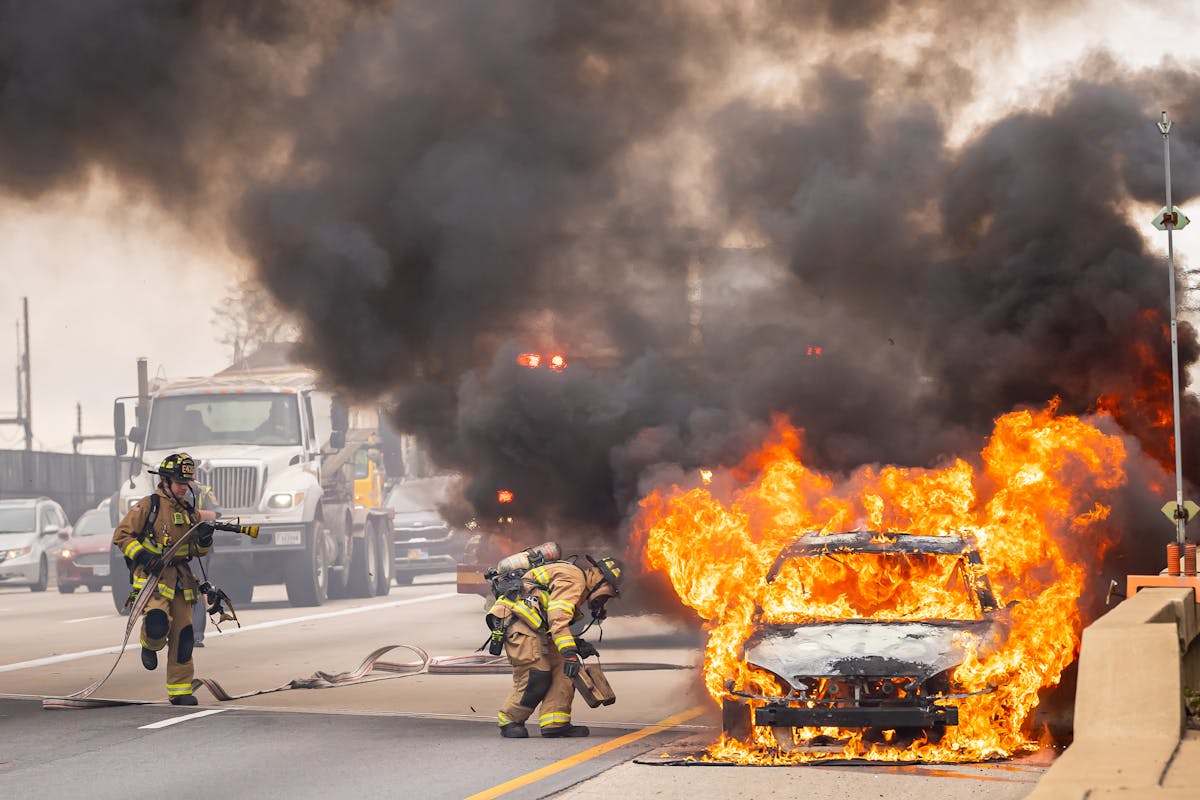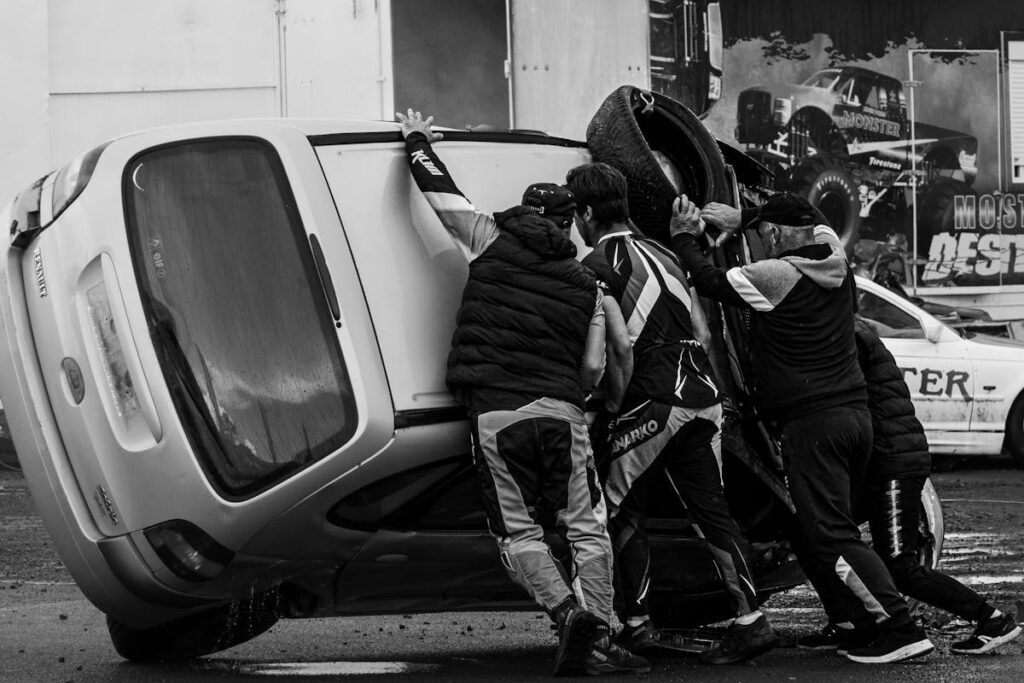In the domain of automotive litigation, key lawsuits such as Grimshaw vs. Ford and Moseley vs. General Motors have not only held corporations accountable for negligence and design flaws but have also paved the way for significant shifts in safety regulations and standards. The long-term impact of these landmark cases has been profound, leading to enhanced vehicle safety scrutiny, heightened consumer awareness, and a cultural shift towards safety prioritization. It begs the question, what other ripple effects have these lawsuits had on the automotive industry and consumer protection at large?
Grimshaw vs. Ford Motor Company
In the annals of automotive history, the case of Grimshaw vs. Ford Motor Company stands as a pivotal moment. This case, which revolved around the fiery crash of a Ford Pinto, set significant legal precedents and highlighted the paramount importance of corporate accountability.
Grimshaw, a passenger in the ill-fated Pinto, suffered severe burns in the crash and subsequently sued Ford. It was discovered during the trial that Ford had known about the Pinto’s propensity to catch fire in rear-end collisions but had chosen not to rectify the problem due to cost considerations. This shocking revelation led the jury to award Grimshaw a staggering $127.8 million in damages, a sum that was later reduced on appeal.
The Grimshaw case underscores the fact that corporations cannot place profit over safety. This landmark case not only influenced the design process of automobiles but also established a legal precedent where corporate negligence resulting in human harm would be met with severe punitive damages. Ultimately, the case of Grimshaw vs. Ford reinforced the necessity of corporate accountability, a principle that continues to shape the legal and ethical landscape of the automotive industry.
Moseley vs. General Motors
Moving our focus to the Moseley vs. General Motors case, we find a pivotal lawsuit that profoundly impacted the car manufacturing industry. By examining the intricate details of the litigation and its subsequent outcome, we can uncover the significant influence it had on vehicle safety standards. This case provides an enlightening lens into the roles of corporate responsibility and regulatory measures in the auto industry.
Case Details and Outcome
The landmark case of Moseley vs. General Motors (GM) is a critical example of the evolving negligence standards and liability implications in car accident lawsuits. In 1996, Patricia Moseley sustained severe burns when her 1987 GM pickup truck exploded following a collision. The Moseleys initiated legal action against GM, contending that the company was aware of a design defect in the fuel system, which increased the risk of fire in accidents.
The jury found GM liable, agreeing that the auto giant had knowingly endangered consumers by failing to correct a known defect, thereby violating the negligence standards. They awarded the Moseleys $4.9 billion in punitive damages, one of the highest compensations in a product liability case. However, on appeal, the award was reduced to $1.2 billion, and later to $295 million to avoid bankruptcy for GM.
The ruling in Moseley vs. GM set a precedent for holding car manufacturers accountable for their negligence. It brought to light the liability implications automakers face when they prioritize profits over safety. Despite the reduction in the final settlement, this case remains a warning for automakers to uphold safety standards or face severe financial repercussions.
Impact on Vehicle Safety
Beyond the massive financial implications faced by General Motors, the Moseley vs. General Motors case had a profound impact on vehicle safety. This landmark lawsuit served as a catalyst for change in automotive regulations, setting new safety standards and shaping legal precedents.
The implications of Moseley vs. General Motors were wide-ranging, influencing not only industry accountability but also consumer awareness. It led to a heightened level of transparency and risk management within the automotive industry, particularly regarding crash testing and the disclosure of results. This transparency prompted an increase in consumer awareness, thereby fostering a culture where safety is prioritized, not compromised.
Technological advancements also emerged from this case, as automakers endeavored to meet new safety standards and avoid litigation. The development of advanced safety features and improved crash testing protocols have since become integral to vehicle design and production.
The Moseley vs. General Motors case is consequently a poignant example of how lawsuits can drive systemic changes within industries. It underscores the importance of legal action in holding corporations accountable and ensuring the continual improvement of safety standards. It serves as a reminder that the safety of consumers is paramount and reinforces the role of legal systems in advocating for public safety.
Anderson vs. General Motors
When it comes to landmark lawsuits involving car accidents, one cannot overlook the case of Anderson vs. General Motors. This case was significant for several reasons, chief among them the successful negligence claims leveled against a major car manufacturer. The case centered around the tragic death of a family due to a fuel tank explosion, raising serious questions about safety regulations in the automobile industry.
The Anderson family’s legal team argued persuasively that General Motors had been negligent in its design and manufacture of the fuel tank, leading to an unnecessary loss of life. They presented a detailed analysis of the manufacturer’s safety protocols. This analysis demonstrated a clear disregard for established safety regulations, leading to an environment where such an accident was not only possible, but likely.
The court agreed with the Andersons’ claims, ruling in their favor. This decision had a profound impact on the automotive industry, leading to stricter safety standards and more rigorous testing protocols. Ultimately, the Anderson vs. General Motors case serves as a sobering reminder of the consequences of negligence, and the crucial importance of robust safety regulations.
Baker vs. Nissan Motor Co
Despite the Anderson vs. General Motors case, manufacturers continued to produce vehicles with defective designs, leading to the landmark Baker vs. Nissan Motor Co. lawsuit. This case centered around a Nissan minivan’s defective design, which resulted in a tragic car accident.
The court’s detailed scrutiny of the vehicle’s dangerous design flaws and Nissan’s neglect of consumer rights was an essential aspect of the case. The defective design, primarily faulty seatbelts and a lack of structural integrity in crash scenarios, led to accusations of Nissan knowingly endangering consumers.
This case serves as a persuasive example of consumer rights in the face of giant automakers. Nissan’s disregard for safety in pursuit of profit was seen as a gross violation of consumer trust and rights. The outcome of the lawsuit had a significant long-term impact on the auto industry, forcing manufacturers to prioritize safety over profit.
Hinton vs. Chrysler Corporation
In the domain of landmark auto-industry lawsuits, the case of Hinton vs. Chrysler Corporation holds significant weight. This case, laden with intricate details and pivotal moments, not only exposed the flaws in Chrysler’s safety measures but also catalyzed sweeping changes across the automotive industry. With a careful examination of the case background and its subsequent impact, we can better understand the profound effects of this legal battle on the landscape of automotive safety standards.
Case Background and Details

The infamous case of Hinton vs. Chrysler Corporation is a striking illustration of how negligence standards and liability insurance intricacies can shape the legal landscape surrounding car accident lawsuits.
In 2004, Hinton, driving a Chrysler vehicle, suffered severe injuries due to a front-end collision. The crux of the case revolved around the alleged defective design of the car’s restraint system, which purportedly amplified the injuries sustained. Chrysler, the defendant, was accused of disregarding negligence standards by failing to employ a safer, feasible design alternative known to the industry.
The plaintiff’s legal team astutely argued that Chrysler’s liability insurance should cover the damages, as the corporation was legally responsible for ensuring the safety of their vehicle’s design. The jury was persuaded by the argument that Chrysler had ample knowledge about the safer alternative design but decided against its implementation, ostensibly to cut costs.
The case was a complex interplay of liability insurance policies, negligence standards, and corporate responsibility, prompting a reevaluation of how safety standards are upheld within the automotive industry. It served as a stark reminder for corporations that cost-efficiency should never supersede safety considerations.
Impact on Automotive Industry
Without a doubt, the Hinton vs. Chrysler Corporation lawsuit had a significant impact on the automotive industry. This landmark case not only garnered public attention but also ignited a shift in regulatory changes and consumer trust.
The lawsuit underscored the importance of safety standards and regulations. It brought to light the fact that these standards were not just legal formalities but essential components in ensuring the safety of consumers. This led to regulatory changes in the automotive industry, with stricter safety guidelines and oversight. These changes, though initially seen as burdensome by manufacturers, eventually led to the production of safer, more reliable vehicles.
Moreover, the case played a pivotal role in shaping consumer trust. The awareness created by the lawsuit made consumers more conscious and discerning about safety features and standards. The automotive industry, recognizing this shift in consumer consciousness, had no choice but to adapt and prioritize these safety standards. Consequently, the Hinton vs. Chrysler case served as a catalyst for a more safety-conscious automotive industry, ultimately benefiting consumers and society as a whole.
Liebeck vs. McDonald’s Corporation
A sizzling dispute of the 1990s, the Liebeck vs. McDonald’s Corporation case fundamentally redefined the negligence standard and consumer awareness. Stella Liebeck, a 79-year-old woman, suffered third-degree burns when she accidentally spilled a cup of McDonald’s coffee on her lap. The lawsuit that followed illuminated a severe lapse in corporate responsibility, sparking a global discourse on the negligence standard.
The case demonstrated the gravity of serving products at unsafe temperatures, which was argued to be an act of negligence. Following a highly publicized trial, the jury sided with Liebeck, awarding her $2.86 million in damages. This verdict was seen as a triumph for consumer rights and a stern warning to corporations.
Furthermore, the case greatly bolstered consumer awareness, prompting companies to review their safety protocols. It served as a catalyst for change, compelling industries to prioritize customer safety above all else.
The Toyota Unintended Acceleration Lawsuit
Moving from one notable case to another, we now turn our attention to the Toyota Unintended Acceleration Lawsuit. This significant litigation, which unfolded from 2009 through 2014, centered around allegations that certain models of Toyota vehicles were prone to unintended acceleration, leading to numerous accidents and fatalities.
The issue raised serious questions about the adequacy of safety regulations in the automobile industry. Plaintiffs argued that Toyota had knowingly concealed a dangerous defect, violating their duty of care to consumers. The company, on the other hand, insisted that driver error was the primary cause of these incidents.
The lawsuit had far-reaching implications for consumer awareness. The media coverage surrounding the case highlighted the importance of consumers having access to accurate information about the safety features of their vehicles. The need for transparency from manufacturers in reporting any potential risks associated with their products was underscored.
Toyota eventually agreed to a settlement, which included financial compensation for affected consumers and a commitment to enhancing safety features on their vehicles. This case continues to serve as a stark reminder of the potential consequences when safety regulations and consumer awareness are compromised.
Long-Term Impact of These Lawsuits
Landmark lawsuits, such as the Toyota Unintended Acceleration case, have far-reaching impacts that ripple through the automotive industry and consumer market alike. These lawsuits set essential legal precedents that not only influence future litigation but also spur change within industry safety standards and practices.
The Toyota case, for instance, led to enhanced scrutiny of vehicle safety and a push for stricter regulatory oversight. It also reshaped compensation structures, with a multimillion-dollar settlement fund established for victims of unintended acceleration incidents. This created a precedent for ensuring that victims are adequately compensated, bringing a sense of justice and closure to those affected.
Moreover, such lawsuits play a significant role in influencing public opinion and consumer behavior. They raise awareness about potential vehicle defects and the importance of regular maintenance checks, thereby fostering a culture of safety among consumers.
Frequently Asked Questions
What Are the Typical Causes of Car Accidents Leading to Landmark Lawsuits?
Typical causes of car accidents leading to significant lawsuits often involve driver negligence, such as distracted or impaired driving, and defective vehicles, where manufacturing or design faults contribute to the occurrence of the accident.
How Have These Lawsuits Influenced Current Vehicle Safety Regulations?
Landmark lawsuits have greatly influenced vehicle safety regulations by prompting vehicle innovations and stricter safety standards. These litigation cases have led to advancements such as seatbelts, airbags, and anti-lock braking systems becoming mandatory features in vehicles.
What Role Does Personal Injury Law Play in These Landmark Car Accident Lawsuits?
Personal injury law is pivotal in car accident lawsuits, primarily through negligence standards and liability determination. It helps ascertain responsibility, quantify damages, and guarantee that victims receive just compensation for their losses.
How Do These Landmark Cases Impact the Insurance Industry?
Landmark cases greatly influence the insurance industry by setting precedents that can increase liability coverage costs. Consequently, insurance premiums may rise, reflecting the heightened risk associated with potential high-payout lawsuits.
What Legal Precedents Were Set by These Landmark Car Accident Lawsuits?
Landmark car accident lawsuits have established essential legal precedents, significantly refining negligence standards and liability definitions. These alterations have guided future rulings, thereby influencing litigation outcomes and reforming legal practices within the automotive accident sphere.

